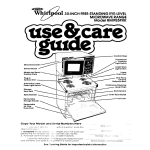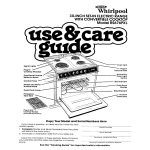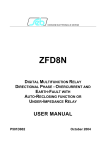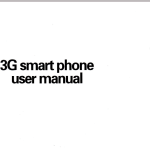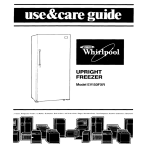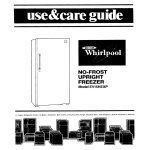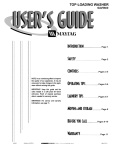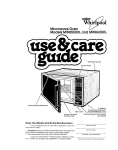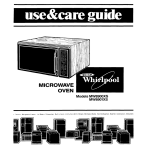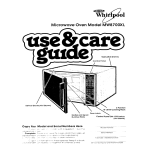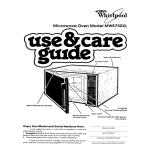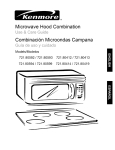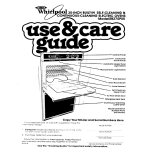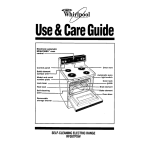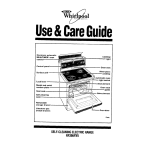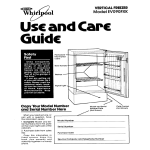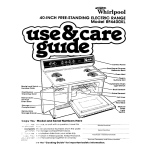Download Whirlpool RM955PXt User's Manual
Transcript
304NCH FREE-SANDING EYE-LEVEL MCROWAVE RANGE Model RM955PXt Mlcrowave Detrost / Ov FhlORWX?flnt cooktop tight Switch Guide Model and Serial Number Plate Automatic Lower Oven Light Switch Oven Rack Guide Bake Eiement Removable Storage Drawer Removable . I . ., - Copy Your Model If you information 1. Complete behind the 2. Purchase and Serial Numbers Here need service, or call with a question, have ready: Model and Serial Numbers (from the plate microwave oven door on the oven frame]. date from sales slip. Model this Serial just Guide for important Number Purchase Copy this information in these spaces. Keep this book, your warranty and sales slip together in a handy place. See Cooklng Number Service safety Company informatlon. Date and Phone Number Your responsfbilities.. . Proper installation and safe use of your microwave range are your personal responsibilities. Read this”Use and Care Guide”and the “Cooking Guide”carefully for important use and safety information. Installation You must be sure your range is... l installed and leveled on a floor that will hold the weight; l installed in a well-ventilated area protected from the weather; l properly connected to the correct electric supply and grounding. [See “Installation Instructions.“) Proper use You must be sure your range is... l used only for jobs expected of home ranges; l used only by people who can operate it properly: l properly maintained. Contents Page Responsibilities .. Installation ....... Proper Use ............ Safety ... .. .. Precautions to Avoid Possible Ex’dosure’to Excessive Microwave Energy ......... Using Your Microwave Upper Oven ...... Setting the Controls ...... ......... Cook Power Chart ... ........... Defrosting Keep Warm : 1: : : : : : : ::::::::: The Meal Sensor’ Temperatu&Probe Meal Sensor’ Temperature Probe Guide ....................... ... Cleaning the Probe ........... ...... Bi-Level Cooking Rack ................ Cleaning the Microwave Oven ......... Important Information ........... ...... How Microwave Ovens Work ........ .. The Microwave Oven Light ............. Using Your Cooktop and lower Oven ..... Surface Unit Controls ...... :. .......... Setting the Clock .................... .. Using the Minute Timer. .............. The Lower Oven Controls ............... The Oven Selector ................... The Oven Temperature Control 2 2 2 3 4 4 5 5 5 5 6 7 7 7 8 8 I0 Io I0 11 12 12 12 12 12 Page Baking or Roasting .......... 13 Adjusting the Oven Temperature Control ......................... 13 Using the Automatic MEALTIMER’ Clock .............................. 14 Broiling .............................. 15 Broiling Chart ........................ 15 The Cooktop Light ................... 16 The Lower Oven Light ................... 17 The Oven Vent ......................... 17 Optional Accessories ................... 17 Rotisserie .............................. 17 Canning Kit ............................ 17 Cleaning and Caring for Your Oven ...... 18 Control Panel and Knobs .............. 18 Surface Units and Reflector Bowls ....... 18 Lift-Up Cooktop ........................ 19 The Oven Door ......................... 20 Storage Drawer ........................ 20 The Continuous-Cleaning Lower Oven .. 21 Cleaning Chart ........................ 22 If You Need Service or Assistance ....... 23 I, Before Calling for Assistance ........ 23 2. If You Need Assistance a ...... 24 3. If You Need Service ................. 24 4. If You Have a Problem ............... 24 3 Using your microwave upper oven ‘Probe Signal Light Meal Sensor Probe Control Digital Timer Cook Power Control Start Button To Stop the Oven: I, Push in and turn the timer knob counterclockwise to 0O:OO. OR 2. Open the oven door. To Restart the Oven: 1. Close the oven door. 2. Set timer (if needed). 3. Push the START Button. Be sure you understand the basics of microwave oven cooking before you start Start with recipes from your MICRO MENUS, Cookbook Follow the directions carefully. NEVER START THE OVEN WHEN IT’S EMPTY. The oven can be damaged For testrng. use at least a cup of water Be sure you have read and understand the dlrectlons. 1. Put food in the oven 4. Set cooking times up to 10 minutes by pushing in the timer knob and turning clockwise. The oven light will go on.To settime for less than 30 seconds, turn timer past 30 seconds, then back to desired time. 2. Close the door Make sure It locks The oven won’t work if the door Isn’t closed trghtly desired setting from HI to KEEP WARM. Some recipes require different Cook Powers for best results. (See chart below). 6. Push the START Button The 5. Set cooking times longer oven light will stay on than 10 minutes by turnrng the trmer knob and You WIII hear a fan runwheel First set the knob ning during oven operation then move the wheel When the set time is up, the oven will shut off automatically. You will hear a bell, the light will go off and the fan will stop. Example: To set 22 minutes, 30 seconds... l Set 2 minutes, 30 seconds by pushing in and turning knob; l Set 20 minutes by pushing up on wheel DEFROSTING For defrosting, set Cook Power Control to DEFROST (MED-LO). See the Defrost Guide inside the oven door or your MICRO MENUS Cookbook for suggested defrost times. COOK POWER CHART Recipes in the MICRO MENUS Cookbook use Cook Power settings from HI to LO. Recipes in other books and magazines may use different percentages of cooking power. The following chart will be helpful: HI - 100% of full power MED-HI - 70% of full power MED - 50% of full power MED-LO (DEFROST] - 30% of full power LO - 15% of full power KEEP WARM 5% of full power -Tmk 3. Set Cook Power to KEEP WARM l l l l l Hot, cooked foods can be safely kept warm for 60 minutes Resetthetimer if more time is required. Keeping foods warm longer than about 1 hour, 40 minutes is not recommended. The quality of some foods will suffer with extended time. Foods cooked covered should be covered during KEEP WARM. Pastry items [pies, turnovers, etc.) should be uncovered during KEEP WARM. Meals kept warm on a plate should be covered during KEEP WARM. 5 THE MEAL SENSOR” TEMPERATURE PROBE The MEAL SENSOR Temperature Probe helps take guesswork out of cooking roasts and larger casseroles. The probe is designed to turn off the oven when it senses the temperature you want. See your MICRO MENUS Cookbook for helpful information in cooking different types of foods For liquids, balance the probe on a wooden spoon or spatula so the tip of the probe is in the center of the liquid. For roasts, the tip of the probe should be in the center of the largest muscle, but not touching fat or bone. Insert at least ’ 3 of the temperature probe into the food. 2. Place food in the oven and plug the probe into the socket on the oven wall. The Probe Signal Light will come on. 3. Make sure the probe does not touch any part of the oven Interlor. Close the door. Set the Cook Power if desired 5. Move the Meal Sensor pointer to the final cooking temperature you want. 6. Push the START Button. When the probe senses the cooking temperature, a buzzer sounds and the oven turns off. For casseroles, the tip of the probe should be in the center of the food. Stir foods when recommended. Replace the probe. 4. DO... l l l l l 6 use hot pads when removing probe from food or food from oven, unplug probe from socket to turn off oven light. stir foods during cooking when recommended. stir soups, casseroles and drinks before serving. cover roasts with foil and let stand a few minutes after cooking. Remove foil if you decide to cook it longer. DON’T... let probe or probe cable touch any part of the oven interior. l let probe touch foil (if used). Foil can be kept away from probe with wooden toothpicks. Remove foil if arcing occurs. 0 use paper, plastic wrap or plastic containers. They will be in the oven too long. l use probe in regular oven. l force probe into frozen food. l use probe for foods that need to simmer. l *Tmk MEAL SENSOR* TEMPERATURE PROBE GUIDE Food Cook Power Settlng Meal Sensor Setting Tips Beverages HIGH 165 Fto 170 F Balance HIGH 170 Casseroles MEDIUM HIGH 170 Fto 175 F Chowders MEDIUM HIGH 180 F MEDIUM 140 F Canned Food Dips Meat Loaf (beef) Poultry Sandwiches on wooden spoon. Use MEDIUM Cook Power for very thick foods such as baked beans. Use MEDIUM Cook Power for very thick mixtures. Stir once or twice. Balance probe once or twice. on wooden spoon. Stir 170 F MEDIUM HIGH Do not use the Meal Sensor probe when cooking poultry. Because of the amount of bone and shape of poultry, there is no place where the meat is thick enough to place the probe properly. MEDIUM 110 F Place sandwich on paper napkin. Insert probe from side so tip is in center of filling. Thick sandwiches work best. HIGH soup F probe 165 Fto 170 F Balance probe once or twice. on wooden spoon. Stir TIPS l l l l in several of the Items -all not heat at the same rate Casseroles cooked using the MEAL SENSOR probe should be made from precooked foods. Do not use raw meats, raw vegetables and cream sauces in casseroles. . Dry meat loaf mixtures Dry casseroles l do not work well Thaw frozen casseroles and meats in the microwave oven before inserting the probe. If you are cooking individual servings such as mugs of soup, check the probe setting CLEANING l don’t work well Remember that roasts may vary in size, shape and composition. Use the timings for minutes per pound as a guideline as well as the MEAL SENSOR probe Starchy vegetables SENSOR probe tend to stick to the MEAL THE PROBE: I. Remove probe from microwave oven using hot pads. 2. Wipe probe with a hot sudsy cloth. Use a plastic scouring pad to remove 3. Probe may be placed in the silverware basket of the dishwasher. 4. Be careful not to kink the cable. NOTE: Make sure you have the right probe for your oven, It will have”LO-Z”on BI-LEVEL the mugs may stubborn foods. the handle. OVEN RACK Use the Bi-Level Oven Rack to stack foods when cooking in more than one container. The rack can be turned upside-down to help fit taller containers on the bottom of the oven. First Pooltlon: Use the rack only when heating SPECIAL CAUTIONS more than one container of food. l Put food in containers, then place conDo not let a container touch the top of theoven. tainers on rack. Second Posltlon: Turn rack upside-down l Do not cook foods directly on rack without when using a taller container on the bottom putting them in containers first. of the oven. l Do not use with browning dish. l Use only in the microwave oven. CLEANING THE RACK l Do not let food or container touch the top of the oven, l Wash by hand with a mild detergent. l Do not store rack in the oven. l Wash on the top rack of a dishwasher. l Use only when cooking foods in more than l Do not use abrasive scrubbers or cleansers. one container. .Tmk 7 CLEANINGTHEMICROWNEUVEN Be sure to clean the areas For stubborn soil, boil a cup Wipe often with warm sudsy where the door and oven of water in the oven for 2 or 3 water and a soft cloth or frame touch when closed. minutes. Steam will soften sponge. The control panel Rinse well. the soil. may becleaned with a soft soapy cloth or spray glass cleaner. Do not use abrasive cleaners or steel wool pads. IMPORmT Before you start using your microwave inform&on will help you avoid Metallic domoge INFORMJXIION oven, read this section carefully. This to your oven. Trim Cooking in metal containers can damage the oven. So can containers with hidden metal [twist-ties, foil-lining, staples, metallic glaze or trim). Test dinnerware or cookware before using. To tesl o dish for safe use, put it into the oven with a cup of water beslde it. Cook on high Cook Power for one minute. If the dlsh gets hot and the water stays cool, do not use It. NEVER COOK OR REHEAT A WHOLE EGG. Slice hard boiled eggs before heating. Steam build-up in whole eggs may cause them to burst and possibly damage the oven. Paper can char or burn, and some plastics can melt if used when heating foods for more than 4 minutes. NEVER start a microwave oven when it’s empty. The oven can be damaged. If you experiment, put a container of water in the oven. Don’t let anything touch the top of the oven Cavity. Continued next page Rough or harsh cleaners DO NOT store things in the can scratch or dull the oven finish. DO NOT USE THEM. Overcooking some foods can cause them to scorch or flame...especially foods like potatoes, corn, snacks, etc. See the MICRO MENUS” Cookbook. -Tmk Make popcorn only in poppers designed for use in microwave ovens Follow popper directions. Results are the popper manufacturer’s responsibility. Liquids heated in certain containers may overheat. The liquid may then splash out with a loud noise. This does not harm the oven, but you should not use such containers to heat liquids again. USE HOT PADS. Microwave energy does not heat containers, but the hot food does. Follow MICRO MENUS’ Cookbook directions carefully to properly cook different types of food. If using a different cookbook, you may need to experiment with times and Cook Powers. l Double-check all settings. l Use the oven only for defrosting, cooking or reheating. If your electric power line voltage is less than the normal 240 volts, cooking times may be longer. DO NOT OVERCOOK POTATOES. At the end of the recommended cooking time they should be slightly firm. Wrap in foil and set aside for 5 minutes They will finish cooking while standing. It is normal for the inside of the oven door to look wavy after the oven has been running for CI while. At times, an extra fan automatically turns on to help protect the microwave oven from excess heat; you may notice a louder sound level when this fan is running. *Tmk HOW MICR- OVENS WORK Microwave ovens are safe. Microwave energy is not hot. It causes make its own heat. and its this heat that cooks the food. Mode Mixer food to Bottom Magqetron I Oven’Cavity Metal Microwaves are like TV waves or light waves. you can’t see them, but you can see what they do. A magnetron produces microwaves. The microwaves move into the oven where they are scattered around by a stirrer (like a fan). Microwaves bounce off metal oven walls and are absorbed by food. The bottom of your microwave oven lets microwaves through. Then they bounce off the metal floor, back through the bottom, and are absorbed by the food. Microwaves pass through glass, paper and plastic without heating them so food absorbs the energy. Microwaves bounce off metal pans so food does not absorb the energy. Microwaves may not reach the center of a roast. The heat around the outside is what cooks the roast all the way through. This is one of the reasons for letting some foods (roasts, baked potatoes) stand for a while after cooking, or for stirring some foods during the cooking time. The microwaves disturb water molecules in the food. As the molecules bounce around bumping into each other, heat is made, like rubbing your hands together. This is the heat that cooks. THE MICROWAVE Floor OVEN LIGHT The light in the microwave oven comes on when the door is open, when a cooking time is set, when the oven is on, and when the temperature probe is plugged into its socket. To replace the light bulb: 1. Move range away from the wall. Be very careful. It is heavy. 2. Unplug the power cord. 3. Remove holding screw on access panel. 4. Remove the cardboard baffle from the bulb. 5. Replace the bulb with a 40-watt appliance bulb. 6. Replace the cardboard baffle and the access panel. 7. Plug in the power cord and move the range back into position. 10 Access Panel Using your cooktop and lower oven COOKTOP AND LOWER OVEN CONTROLS Stop lime Digital Knob Automatic MEALTIMER’ Clock Start Time Knob Minute Timer Adjustable Control Lower Lower Oven Temperature Oven Signal Surface Unit Signal Surface Unit Control Lower Oven Manual Cooktop Light Lights Selector Lower Oven Light Switch Light Switch -Tmk SURFACE UNIT CONTROLS One of the signal lights will glow to remind you which surface unit is on. Be sure all signal lights are off when you are not cooklng. Turn either way until the setting you want shows in the window. Set them anywhere from HI to OFF. lurnlng. . Signal lights match location of surface units on cooktop. PUSH IN. Turn to setting. Until you get used to the settlngs, Use HI to start foods cooking or to bring liquids to a boil. Surface unit will not turn red If good contact Is made wlth bottom of pan. use the following Use MED-HI to hold a rapid boil or lo fry chicken or pancakes. as a guide. Use MED for gravy, puddings and icings. or to cook large amounts of vegetables. See “The Accessory Canning your “Cooking Guide” for information. Use MED-LO to keep food cooking after starting it on a hlgher setting. Kit” (paget7) and important utensil Use LO to keep food warm until ready to serve. Set the heat hlgher or lower wlthln the LO band to keep food at the temperature you want. 11 SETTING THE CLOCK Push in and turn the Minute Timer Knob to set the Clock. 1. Push in Minute Timer Knob and turn clockwise until clock digits show the right time of day. USING THE MINUTE let the Minute Timer Knob pop out. Turn counterclockwise until the Minute Timer dial shows OFF. The clock setting will change it you push in when turning. TIMER DO NOT PUSH IN THE KNOB when setting 1. 2. the Minute Imer Without pushing in the Minute Timer Knob, turn it until the time showing in the window is longer than you want. 2. Without pushing in, turn the knob back so the setting you want shows in the window. 3. When the time is up, a buzzer will sound. To stop the buzzer, turn the dial to OFF without pushing in the knob. PUSHING IN AND TURNING THE KNOB CHANGES THE CLOCK SETTING. THE LOWER OVEN CONTROLS The lower oven is controlled by two knobs: the Oven Selector and the Oven Temperature Control. Both must be on a setting for the oven to heat. THE OVEN SELECTOR With the Oven Selector on BROIL, only the top element heats. (Broiling, pg. 15). With the Oven Selector on BAKE, the bottom element does most of the work. The top element heats, but does not turn red. [Baking, pg.13). THE OVEN TEMPERATURE CONTROL Use the Oven Temperature Control to set baking or roasting temperature when the Oven Selector is on BAKE or TIMED. 12 When both the Oven Selector and Temperature Control are on BROIL, the broil element heats all the time. The With the Oven Selector on TIMED, the MEALTIMER- Clock can be used to turn the oven on and off automatically. (MEALTIMER Clock, pg.14). ‘Tmk Oven Temperature Control can be set on a temperature for slower broiling (see Broiling, page15). Put the rack(s) where YOU 6-3 want them before turning on the oven. Rack(s) should be placed so food can be centered in the oven. Always leave at least 11’~to 2 inches (4-5 Cm] between the sides of the pan and the oven walls and pans. For more information, see the “Cooking Guide.” Lift rack at front and pull out. Set the Oven Selector BAKE. Let the oven preheat until the Signal Light goes off. Set the Oven Temperature Control to the baking temperature you want. on 6 During baking, the elements will turn on and off to help keep the oven temperature at the setting. The Signal Light will turn on and off with the elements. The top element helps heat during baking, but does not turn red. Put food in the oven. Oven rock we//s and door ADJUSTING will be hot. When baking is done, turn both knobs to OFF. THE OVEN TEMPERATURE CONTROL Does your new oven seem to be hotter or colder than your old oven at the same settings? The temperature setting in your old oven may have changed gradually overthe years. The accurate setting of your new oven can seem different. If you think the oven temperature needs adjusting, follow these steps: 1. Pull the Oven Temperature Control straight Off. 2. Tlghten Loosen the locking screw; NOTICE position of notches. the locking screw. 3. To lower the ternperature, move black part of knob closer to LO. Each notch equals about 10°F (5°C). Replace 4. To raise the temperature, move black part of knob closer to HI. Each notch equals about 10°F (5°C). the knob. 13 USING THE AUTOMATIC MEALTIMER:. CLOCK The Automatic MEALTIMER Clock is designed to turn the lower at times you set...even when you are not around. To start and stop baking 1. Put the lower oven rack(s) where you want them and place the food in the oven. 4. Push in and turn the Stop lime Knob clockwise to the time you want the oven to shut off 7. After baking is done, both knobs to OFF. To stop baking automatically: turn 2. 5. 8. Make sure the clock is set to the right time of day. Set the Oven Selector TIMED. 6. Push in and turn the Start Time Knob clockwise to the time you want baking to start. Set the Oven Temperature Control on the baking temperature you want. automatically: Put the oven rack(s) where you want them and place the food in the oven. 2. Make sure the clock is set to the right time of day. Push in and turn the Stop fime Knob clockwise to the time you want the oven to shut off. SPECIAL CAUTION: Use foods that will not go bad or spoil while waiting for cooking to start. Avoid using dishes with milk or eggs, cream soups, cooked meats or fish, or any item with baking powder or yeast. Smoked or frozen meatsmay be used; so can vegetables, fruits and casseroletype foods. Vegetables can be cooked in 14 on 3. To stop the oven before the preset time, turn both knobs to OFF. 1. 3. oven on and off 4. Set the Oven Selector on TIMED. 5. Set the Oven Temperature Control on the baking temperature you Want. 6. After baking is done, turn both knobs to OFF. 7. To stop the oven before the preset time, turn both knobs to OFF. a covered baking dish with about a halfcup (118 mL) of water for 1 to 1% hours. Any food that has to wait for cooking to start should be very cold or frozen before it is put in the oven. MOST UNFROZEN FOODS SHOULD NEVER STAND MORE THAN TWO HOURS BEFORE COOKING STARTS. BROILING 1. Place the rack where want if for broiling. you 2. Put the broiler pan and food on the rack. 3. Setthe Oven Selector BROIL. 4. Set the Oven Temperature Control on BROIL (or on a lower temperature for slower broiling). 5. During broiling, the oven door must be partly open. A built-in stop will hold it there. 6. When broiling is done, turn both knobs to OFF. on For slower broiling, set the Oven Temperature Control on a temperature instead of BROIL. The broil element will then turn on and off instead of staying on. The lower the temperature setting, the slower the broiling. The Oven Selector must be on BROIL and the door partly open for all broiling temperatures. Suggested oven-rack Food Beef Steaks Rare Medium Well done Beef Steaks Rare Medium Well Done Hamburgers Lamb Chops Medium Ham slice, precooked or tendered Canadian Bacon Pork Rib or Loin Chop Well done Chicken Fish Liver Frankfurters positions and broiling times Approximate Temperature 1st side Minutesset to BROIL 2nd side Description inches (cm) from top of food to Broil Element 1” (2.5 cm) l”(2.5 cm) 1” (2.5 cm) 3”(B cm) 3” (8 cm] 3” [B cm) 7-9 9-11 11-13 3-5 4-7 5-7 1 I 2” (4 cm) 1 l 2” (4 cm] 1 ’ 2” (4 cm] 12” (1 cm) 4”-5” 4”-5” 4”-5” 3” [ 8 13-l 5 17-19 19-21 6-8 6-8 8-l 0 14-16 4-5 1 ” [ 2.5 cm) ‘~“-1” (I-2.5 cm) ?2” (1 cm) 3,4 “-1 ” (2-2.5 cm) 2-3 lb. (l-l.5 kg) cut in half whole fillets q2”-3,“ (A-2 cm) 3” (8 cm) 6-8 4-5 3” [ 8 cm) 3” [8 cm) 6-8 6 4-5 4 (1 O-l 3 cm) (1 O-l 3 cm] (1 O-l 3 cm) cm] 4”-5” (1 O-l 3 cm) 15 10 7”-9” (18-23 cm) 3”(8 cm) 3” (8 cm) 25-30 It-16 7-8 1 O-l 2 9-14 5-7 3” (8 cm) 4”-5” (1 O-l 3 cm) 3 6-7 3 4-5 15 THE COOKTOP LIGHT To turn on the fluorescent light under the upper oven, push the button underthe control panel marked TOP LITE. Hold it in for a second before letting it go. Push it again to shut off the light To replace the light tube: 1. Turn off the electric power at main power supply. 2. Remove the 3 screws and front metal trim that supports the light cover. The glass is heavy. Hold it securely. 3. Wlth both hands, lower the front of the cover a little and pull it straight toward you. 4. Turn top of fluorescent tube toward you until it comes out of the receptacles at both ends. 5. Replace with a 20-watt cool-white fluorescent tube. 6. With both hands, carefully fit the glass cover into the metal support trim at the back. 7. Slide the cover back far enough for the front to fit behind the spring tabs at the ends. 8. Replace the front support trim and the 3 screws. 9. Turn electric power back on at main power supply. THE LOWER OVEN LIGHT The lower oven light will come on when you open the oven door or when You push the Oven Light switch at the bottom of the control panel. Close the oven door or push the switch again to shut it off. To replace 1. the light bulb: Turn off the electric power at the main power SUPPlY. 2. Remove the light bulb from its socket. 3. Replace the bulb with a 40-watt appliance bulb available whereever light bulbs are sold. 4. Turn electric power back on at main power SUPPlY. THE OVEN VENT Hot air and moisture escape from the lower oven through a vent under the right rear SUrfCXe unit. You can cook on the unit, or keep food warm on it while the oven is on. Plastic utenslls lett over the vent can melt. Do not block the vent. Poor baking can result. Optional Accessories ROTISSERIE If you would like a rotisserie for your lower oven, You can order a kit (Part No. 261880) from your dealer. The kit includes easy installation instructions. CANNING KIT (Part No. 242905) The large diameter of most water-bath or pressure canners combined with high heat settings for long periods of time can shorten the life of regular surface units and cause damage to the cooktop. If you plan to use the cooktop for canning, we recommend the installation of a Canning Kit. Order the kit from your Whirlpool Dealer or Tech-Care Service Company. Use only flat-bottomed utensils for best results and to prevent damage to the range. Specialty items with rounded or ridged bottoms (woks, ridged bottom canners or tea kettles) are not recommended. See the “Cooking Guide” for important utensil information. SEE THE “COOKING GUIDE”FOR IMPORTANT CANNING INFORMATION 17 Cleaning and caring for your range CONTROL PANEL AND KNOBS 1. First make sure lower oven and surface unit control knobs are set on OFF. Ail knobs pull straight off. Surface unit knobs have a collar and spring. 2. Use warm soapy water and a soft cloth to wipe the panel. Rinse and wipe dry. Collar \- FLU \ / f N !J 3. Wash knobs and surface unit collars warm soapy water. Rinse well and dry. in 4. Put small end of sprlng closest to control panel. Push knobs straight back on. Make sure they point to OFF. Make sure the collar and spring on surface unit knobs are put together as shown. SURFACE UNITS AND REFLECTOR BOWLS REMOVING 1. Be sure surface units are OFF and COOL. 2. Lift the edge of the unit opposite the receptacle just enough to clearthe reflector bowl. Receptacle 3. 18 Pull the surface receptacle. unit straight away from the 4. Lift out the reflector bowl REPLACING Receptacle I. Be sure surface 2. Line up opening in the reflector the surface unit receptacle. unit controls are OFF. bowl 3. with 4. While pushing the surface unit terminal into the receptacle, lift a little on the edge of the unit nearest the receptacle. 5. When the terminal is pushed into the receptacle as far as it will go, the surface unit will fit into the reflector bowl. Hold the surface unit as level as possible with the terminal just started into the receptacle. Reflector bowls reflect heat back to the utensils on the surface units. They also help catch spills. When they are kept clean, they reflect heat better and look new longer. If a reflector bowl gets discolored, some of the utensils used may not be flat enough. Or some may be too large for the surface unit. In either case, some of the heat that is meant to go into or around a utensil goes down and heats the reflector bowl. This extra heat can discolor it. LIFT-UP COOKTOP 1. Lift the front of the cooktop at the center and swing the support rod up. 2. Carefully lowerthe cooktop onto the support rod. Be sure the tip of the rod fits in the notch in the cooktop. 3. Wipe with warm soapy water. Use soapy steel wool pad on stubborn spots. DO NOT let the cooktop bump the upper oven when lifting. DO NOT drop the cooktop. Damage can result. 19 THE OVEN DOOR REMOVING THE LOWER OVEN DOOR Open the door to the first stop Hold the door at both sides and lift It at the same angle is in. REPLACING THE LOWER OVEN DOOR it THE MICROWAVE OVEN DOOR CANNOT BE REMOVED. Fit the bottom corners of the door over the ends of the hinges Push the door down evenly. The door will close only when it IS on the hinges correctly. STORAGE DRAWER The storage drawer is for storing pots and pans. Never store anything that can burn or melt in the drawer. The drawer is warm when baking in the lower oven. Use care when handling the drawer. REMOVING THE STORAGE DRAWER 1. Pull drawer straight the first stop. out to 2. Lift front and pull out to the second stop. 3. Lift back slightly and slide drawer all the way out. 3. Lift drawer front to clear second stop and slide drawer closed REPLACING THE STORAGE DRAWER Drawer 1. 20 Slide Rail Fit ends of Drawer Slide Rails into drawer guides both sides of opening. - 2. on Lift drawer front and push in until metal stops [on drawer slide rails) clear white stops on drawer guides. THE CONTINUOUS-CLEANING LOWER OVEN Standard oven walls are coated with smooth porcelain-enamel. Your continuous-cleaning oven walls are coated with a special, rougher porcelain-enamel. A fat spatter beads up on the smooth surface, but spreads out on the rougher surface. The bead of fat chars and turns black. The spread-out fat gradually burns away at medium to high baking temperatures (350 -475 F,176 -231 C] so the oven can return to a presentably clean condition. Standard porcelain-enamel Continuous-cleaning porcelain-enamel USING FOIL Foil must be used on the lower oven bottom to catch spillovers. The foil must be used properly. Cut foil from a roll of heavy-duty 18-inch (45 cm) aluminum foil, or buy a foil kit (Part No. 241430) from your Whirlpool Appliance dealer. Lift the cool bake element slightly to lift the feet off the oven bottom. Slidethefoil underthe bake element. Make sure foil is centered, long enough to start up both sides, and lying flat without wrinkles. For proper baking, lower thd ba <e element so-all feet rest solidly on the foil. TIPS 1. The oven window and racks are not coated. Clean them by hand. 2. The oven door does not get as hot as the walls. Some hand cleaning may be needed. 3. If you do more broiling than baking, cleaning may be needed. 4. Use aluminum foil on the oven bottom according to instructions. Spillovers do not burn away and may stain the bottom. hand 4 HAND CLEANING \ “j$: : .’ _. DO NOT USE OVEN CLEANING PRODUCTS. Some can be trapped in the porcelainenamel surface and give off harmful fumes. RACKS - Use a soapy WINDOW - Keep clean steel-wool pad for best with hot sudsy water. results. Rinse well. Do not use steel wool or abrasive cleansers. Use a WALLS AND DOOR - Wash with hot soapy plastic scouring pad for water. Use a soapy steel-wool pad or stubborn spots. Rinse plastic scouring pad for stubborn spots. well. Rinse well. CLEANING PART Outside range of WHAT TO USE Soft cloth, warm soapy water Nylon or plastic scouring pad for stubborn spots Surface units No cleaning Chrome reflector bowls Automatic dishwasher or warm, soapy water or plastic scrubbing pad Control knobs and chrome rims Control panel Warm, sudsy water and bristle brush Broiler pan and grid Oven rocks Lower oven door glass and outside only of microwave oven Continuous Cleaning Oven 22 required Warm, soapy water Commercial glass cleaner Warm, soapy water or soapy steel wool pads Warm, soapy water or soapy steel wool pads Warm, soapy water or plastic scrubbing pad Commercial glass cleaner l CHART HOW TO CLEAN Wipe off regularly when range is cool. Do not allow food containing acids (such as vinegar, tomato, lemon juice or milk] to remain on surface. Acids will remove the glossy finish. l Do not use abrasive or harsh cleansers. l Spatters or spills will burn off l Do not immerse in water. 0 Clean frequently. l Wash with other cooking utensils. l Do not use harsh abrasives. l Wash, rinse and dry well. l Do not soak. l l l l l l l Wash, rinse and dry with soft cloth. Follow directions with cleaner. Wash with other cooking utensils. Wash, rinse and dry. Use soapy steel wool pads for stubborn areas. Make certain oven is cool. Wash, rinse and dry well with soft cloth. Follow directions provided with cleaner. Clean stubborn spots or stains. Rinse well with clean water. l Do not use commercial oven cleaners. l Place strip of aluminum foil on bottom of oven to catch spillovers. See page 21. l Follow directions given on page 21. Most fat spatters on porcelain-enamel interior surface gradually reduce to a presentably clean condition during normal baking or roasting operations. Warm, soapy water or soapy steel wool pads l If you need service or assistance, we suggest you follow these four steps: 1 l Before calling for assistance.. . Performance problems often result from little things you can find and fix yourself without tools of any kind. If nothlng operates: l Is the range correctly plugged into a live circuit with the proper voltage? (See Installatlon Instructlons.) l Have you checked the main fuse or circuit breaker box? If the mtcrowave oven will not run: l Is the timer set? l Is the Cook Power set? l Is the door firmly closed ? l Did you push the START Button? l Did you follow the directions on page 5 exactly? If mlcrowave cooking times seem too long: Is the electric supply to your home low or lower than normal? Your electric company can tell you if the line voltage is low. l Is the Cook Power at the recommended setting? l Are you allowing for more time when cooking more food at one time? If the mlcrowave oven turns off too soon or not soon enough when uslng the probe: l Is at least 13 of the probe in the food? l Is the probe tip in the center of the food? l Is the probe touching bone or fat? l Have you allowed roasts to stand for a few minutes after cooking? l Is the probe plugged tightly into its socket? l Is the Cook Power set where it should be? l Is the Meal Sensor set at the end temperature you want? If the lower oven will not operate: l Is the Oven Selector turned to CI setting [BAKE or BROIL, but not TIMED]? l Is the Oven Temperature Control turned to a temperature setting? l If surface unlts will not operate: l Have you checked main fuse or circuit breaker box? l Are surface units plugged in all the way? l Do the control knobs turn? If surface unlt knob or knobs will not turn: l Did you push in before trying to turn: l Is the spring replaced as shown on page1 8? If sol1 is visible on continuous-cleaning oven finish: l The special finish is designed to gradually reduce oven soil during normal baking or roosting. It is not designed to keep your oven spotlesssonly presentably clean. l If you broil offer-, you may see oven soil. l The door is cooler than oven walls. Soil will be more visible on the door than other areas in the oven. See page 21, “Hand Cleaning.” If cooking results aren’t what you expect: l Is the range level? l Are you using pans recommended in the Cooking Guide? l If baking, hove you allowed I1 2 to 2 inches (4-5 cm) on all sides of the pans for air circulation? l Does the oven temperature seem too low or too high? See page1 3, “Adjusting the oven temperature control.” l Have you preheated the oven as the recipe calls for? l Are the pans the size called for in the recipe? l Are you following a tested recipe from a reliable source? l Do the cooking utensils hove smooth, flat bottoms? l Do the cooking utensils fit the surface unit being used? See the Cooking Guide for more information on cooking problems and how to solve them. 23 2 l 4 Ifyou need assistance”‘. . . Call the Whirlpool COOL-LINE ’ service assistance telephone number. Dial free from: Continental U.S. . . . . . . . . (800) 253-1301 Michigan . . . . . . . . . . . . . . . . (800) 632-2243 Alaska 81 Hawaii . . . . . . . . (800) 253- 1121 and talk with one of our trained Consultants. The Consultant can instruct you in how to obtain satisfactory operation from Your appliance or, if service is necessary, recommend a qualified service company rn your area. 3 l If you need service’,. . . . Whirlpool has a nationwide network of franchised TECH-CARE’ Service Companies. TECH-CARE service technicians are trained to fulfill the FRANCHISED SERVICE product warranty and provide afterwarranty service, anywhere in the United States. To locate TECH-CARE service in Your area, call our COOL-LINE service assistance telephone number (see Step 2) or look in Your telephone directory Yellow Pages under. l If you have a problem’~’ . . . Call our COOL-LINE service assistance telephone number (see Step 2) and talk with one of our Consultants, or If You prefer, write to: Mr. Guy Turner, Vice President Whirlpool Corporation Administrative Center 2000 US-33 North Benton Harbor, Ml 49022 If You must call or write, please provide: model number, serial number, date of purchase, and a complete description of the problem. Thus information IS needed in order to better respond to your request for assistance. 7&k9RE APPLIANCES-HOUSEHOLDMAJOR-SERVICE 8 REPAIR ELECTRICAL APPLIANCESMAJOR-REPAIRING 8 PARTS OR i4HIRLPOOLAPPLIANCES FRANLHISED TECB CARE SERVICE ~"~HIRLPOOLAPPLIANCES :RANLHlSEDrECH CARESERLICE \.+..ii\,c t X:SER\II.F 12: %p1r c O\ll'~ IO \t./<\/c t. c 01,,'\ \lt.\ r~~'SERVICE CO '2' Mao~F 999 Y9QQ 1/t \ Q99 999'1 OR WASHING MACHINES. 8 IRONERS-SERVICING DRYERS ~~HIRLPOOLAPPLIANCES FRANCHISEDTECH CARf SERLICE tt.H\ I( t., o\//‘\\/t XYLSERVICE CO 123 Maple \ 099 9999 FSP is o registered trademark of Whrrlpool Corporation tot quality parts. took for this FSP symbol ot quality whenever R you need o replacement part for your Whirlpool applronce FSP replacement parts will fit right and work right, because they are made to the same exacting speciticaiions used to build every new Whirlpool appliance. 0 Benlon Harbor, Michigan. Automatic Washers, Clothes Dryers. Freezers, Retrigeratnr-Freezers. Ice Makers. Dishwashers. guilt.in Ovens and Surtace Units, Ranges. Mrcrowave Ovens, Compactors, Room Air Conditioners. Dehumiditiers. Central Heahng and Air Conditioning Systems. Part No. 311430 Printed in U.S.A.
























